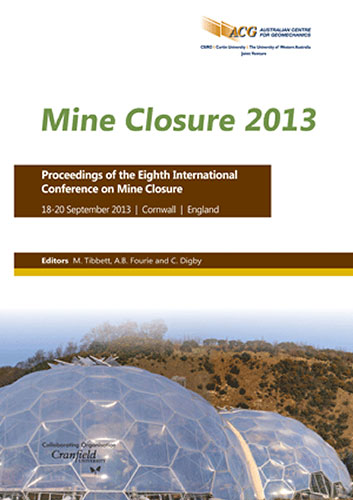Taking the risk out of a risky business: a land use approach to closure planning

|
Authors: Hattingh, R; Bothma, J |
DOI https://doi.org/10.36487/ACG_rep/1352_02_Hattingh
Cite As:
Hattingh, R & Bothma, J 2013, 'Taking the risk out of a risky business: a land use approach to closure planning', in M Tibbett, AB Fourie & C Digby (eds), Mine Closure 2013: Proceedings of the Eighth International Seminar on Mine Closure, Australian Centre for Geomechanics, Cornwall, pp. 15-23, https://doi.org/10.36487/ACG_rep/1352_02_Hattingh
Abstract:
Closure planning is an integral but sometimes forgotten aspect of life-of-mine planning. And for those mining houses that do put the required effort into formulating appropriate, practical closure objectives, these are often guided by environmental, social, financial and reputation-related risks to the company and are not necessarily the most suitable required end-state for the area. However, more and more emphasis is being placed on the need for dedicated, upfront land use planning to identify the most suitable post-mining end land use/s prior to the initiation of mining operations, as well as on the importance of this land use approach to the sustainability of the closure approach adopted. Understanding the post-mining closure environment requires a good grasp on the end-state land use, which influences the formulation of closure objectives and associated measures, closure cost estimates as well as cost implications during the remaining operational phase and the direction of creative solutions, along with providing transparent commitment towards affected parties/stakeholders. Furthermore, understanding the opportunities and constraints of the possible post-mining landscapes, whether they are environmentally and/or socially driven, empowers an operation to identify the most practical, cost-effective solutions for the post-mining landscape, most of which can be implemented during the operational phase, whilst creating opportunities for those communities remaining after final site relinquishment.
References:
Andrews-Speed, P., Ma, G., Shao, B. and Liao, C. (2005) Economic responses to the closure of small-scale coal mines in Chongquing, China, Resources Policy, Vol. 30(1), pp. 39–54.
Carrick, P.J. and Krűger, R. (2007) Restoring degraded landscapes in lowland Namaqualand: lessons from the mining experience and from regional ecological dynamics, Journal of Arid Environments, Vol. 70, pp. 767–781.
Doupé, R.G. and Lymbery, A.J. (2005) Environmental risks associated with beneficial end uses of mine lakes in Southwestern Australia, Mine Water and the Environment, Vol. 24, pp. 134–138.
Evans, L. (2006) Science and technology for end-uses after mining, International Journal of Mining, Reclamation and Environment, Vol. 20(2), pp. 83–84.
Hancock, G.R., Loch, R.J. and Willgoose, G.R. (2003) The design of post-mining landscapes using geomorphic principles, Earth Surface Processes and Landforms, Vol. 28, pp. 1097–1110.
Limpitlaw, D., Aken, M., Lodewijks, H. and Viljoen, J. (2005) Post-mining rehabilitation, land use and pollution at collieries in South Africa, in Proceedings Colloquium: Sustainable Development in the Life of Coal Mining, South African Institute of Mining and Metallurgy, Boksburg, 13 July 2005, 10p.
Mchaina, D.M. (2001) Environmental planning considerations for the decommissioning, closure and reclamation of a mine site, International Journal of Surface Mining, Reclamation and Environment, Vol. 15(3), pp. 163–176.
Morrey, D.R. (1999) Integrated planning for environmental management during mining operations and mine closure, Minerals & Energy - Raw Materials Report, Vol. 14(3), pp. 12–20.
Murphy, D.P., Marshall, R.C. and Duff, G. (2007) Demolition – the forgotten closure strategy, in Proceedings Second International Seminar on Mine Closure, A. Fourie, M. Tibbett and J. Wiertz (eds), Perth, Australia, Australian Centre for Geomechanics.
Pearman, G. (2009) 101 Things to Do with a Hole in the Ground, Post Mining Alliance, Eden Project, Bodelva, UK.
Schulz, F. and Wiegleb, G. (2000) Development options of natural habitats in a post-mining landscape, Land Degradation & Development, Vol. 11, pp. 99–110.
Soltanmohammadi, H., Osanloo, M. and Bazzazi, A.A. (2010) An analytical approach with a reliable logic and a ranking policy for post-mining land-use determination, Land Use Policy, Vol. 27, pp. 364–372.
Stacey, J., Naude, A., Hermanus, M. and Frankel, P. (2010) The socio-economic aspects of mine closure and sustainable development: literature overview and lessons for the socio-economic aspects of closure – Report 1, Journal of the Southern African Institute of Mining and Metallurgy, Vol. 110, pp. 379–394.
Warhurst, A. and Noronha, L. (2000) Corporate strategy and viable future land use: planning for closure from the outset of mining, Natural Resources Forum, Vol. 24, pp. 153–164.
© Copyright 2025, Australian Centre for Geomechanics (ACG), The University of Western Australia. All rights reserved.
View copyright/legal information
Please direct any queries or error reports to repository-acg@uwa.edu.au
View copyright/legal information
Please direct any queries or error reports to repository-acg@uwa.edu.au